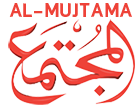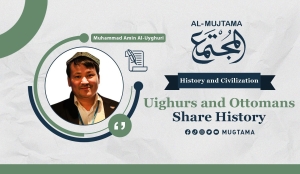
Muhammad Amin Al-Uyghuri
Uighurs and Ottomans Share History
March 10, 2024The term “Uighur” is an ancient Turkish word meaning union and alliance. Several Turkish tribes were named “Uighurs” after the union that occurred among them, and the main bloc of Turkish people lived in a state of peace or conflict with the Chinese for hundreds of years, dating back to centuries before Christ.
Historical references document the most significant of these relationships in the history of the Turks during the time of the “Hunnic Empire” (led by Oghuz Khan, who united most Turkish tribes under his control) from the 3rd century BCE to post-Islamic times in the era of the “Göktürk Empire” (542–740 CE), followed by the Uighur state (845–1600 CE).
Some sources also mention that Kashgar, one of the major cities in East Turkestan, encountered Islam during the Umayyad period. Al-Tabari mentions the following about Kashgar: “Qutayba ibn Muslim advanced from the region of Farghana to Kashgar (the capital of East Turkestan throughout the ages) in the year 96 AH/715 CE and took it from the Chinese, who had occupied it since 629 CE.”
Then, Islamic history, prosperous with knowledge and civilization for the Turks in general, began with the leadership of the Qarakhanid (842–1212 CE) and the Seljuks, representing the majority of Muslim Turks without highlighting the name of one tribe over another in general. This information is according to Turkish and Chinese historical sources.
As for the relationship between the Uighur Turks and the Turks from whom the Ottoman Empire descended, the former remained in their homeland, Greater Turkestan, and engaged with the Mongols in the country's politics. They preserved their Islamic and ethnic identities to the extent that even the Mongolian lineage later embraced Islam. As to the latter, they migrated from Turkestan to the West, including Anatolia, Iraq, and Syria, either aligning with the Mongols or fleeing from them to establish their emirates and states in these regions.
From these emirates and states emerged the Uighur Karakorum State, which ruled vast regions in eastern Anatolia, Iran, Iraq, and Kuwait between 1315 and 1379 CE. Similarly, the Uighur Artana State was established in central Anatolia under the leadership of Sultan Ala ad-Din, and its rule persisted for about half a century, establishing mosques and schools in the country.
However, after the Mongol occupation of Turkish lands and the fall of emirates and states under their control at the end of the 12th century AD, the foundations of the Ottoman Empire began to form. It brought together the remaining Turkish tribes in Asia Minor (Anatolia) in opposition to the Mongol Chagatai State and later the Timurid Turkish State in Greater Asia (Greater Turkestan).
In this politically and socially intertwined situation, it is natural for relations between the Ottoman Turks and the Uighur Turks to divert in trade and cultural exchange. However, the adherence to the Hanafi school of thought and the Maturidi creed in both geographic regions indicates a strong unity and alignment in military and doctrinal forces.
In some sources, such as the book “Sultans of the Ottoman Empire,” it is mentioned that during the reign of Sultan Suleiman the Magnificent in the 16th century AD, a delegation of five individuals was sent five times through the Silk Road passing through Turkestan. The main purpose of this delegation was trade only, despite its small number.
According to some Ottoman documents, Sultan Mehmed the Conqueror wrote his orders to the authorities in Baghdad at that time in the Uighur language. It is also noted that he took pride in his knowledge of the Uighur and Arabic languages, which were considered languages of science and politics at that time.
This information collectively indicates that relations were close between Anatolia and East Turkestan in terms of religion and ethnic brotherhood. However, political situations and prevailing wars intervened between the two sides. For instance, the Safavid state's disrupted geographical connections between them.
As to the Turks who remained in Greater Turkestan, especially the Uighur descendants of the Mongolian dynasty, they lived from the 15th to the mid-18th century under the lineages of the Timurid Empire first, then the Saadi’s and others in the vast Turkestan lands, till their struggle with the Russians and the Manchurian Chinese began in the 18th century after the fragmentation and creed divisions prevailed among them. The Russians and the Manchurian Chinese took advantage of these fragmentations and divided them. The Russians governed Western Turkestan, while Manchurian China controlled Eastern Turkestan in the late 19th century.
Researchers and writers often overlook the distinction when defining Muslims in China and East Turkestan, which is very significant. Turkestan is a vast region inhabited by Turkic ethnicities, including Uighur, Uzbeks, Kazakhs, and others, who embraced Islam during the Islamic conquests of the late 1st century AH.
The Manchurians initiated their colonial occupation of East Turkestan in 1858–1859, and they were defeated by the Uighurs led by Yakub Beg. They were then able to establish their state again, known as the “Kashgaria State/Yaqub Beg State” in 1863.
In 1867, Yaqub Beg pledged allegiance to Sultan Abdulaziz, making Turkestan and its people part of the Ottoman Empire, unifying the Turks East and West. The Sultan supported the reunification of Turks by providing them with some military weapons and sending them the blue flag as the Ottoman state's emblem, but this did not last long due to the weakening of the Ottoman Empire.
In return, Russian and Chinese ambitions in those lands increased. The Russians occupied Western Turkestan, while the Chinese occupied Eastern Turkestan in 1884, renaming it “Xinjiang,” meaning “new homeland.” China severed all relations and assistance between the Ottoman Empire and this region, where they committed brutal massacres.
More importantly, Sultan Abdulhamid II's plan to support Muslims in the East was comprehensive, including Muslims in Eastern Turkestan and all Chinese Muslims. His vision of restoring “the Islamic Caliphate” may have influenced extending his support from only his Turkish Turkestan ancestors to comprehensive and long-term aid to all Chinese Muslims. Thus, he established the “Darul Uloom Hamidiyah” in Beijing, the capital of China.
In Eastern Turkestan, he indirectly assisted in establishing religious schools and renovating the “Hamidiyah School,” and the “Dar al-Moalmeen” in i like Baha ad-Din Bey and Hussein Bey, facilitating the transfer of factories from Germany.
He sent Turkish teachers for guidance and education to train and teach young students. Additionally, by supporting the establishment of advanced factories and transferring them from Europe to Turkestan, he contributed to the development of Turkestan society. Despite Russian and Chinese policies toward Muslims, Eastern Turkestan became more advanced and civilized than China. Many correspondences occurred between the Sublime Porte and Turkestani leaders and judges, serving as strong evidence of this support.
-------------------------------------------------------------


